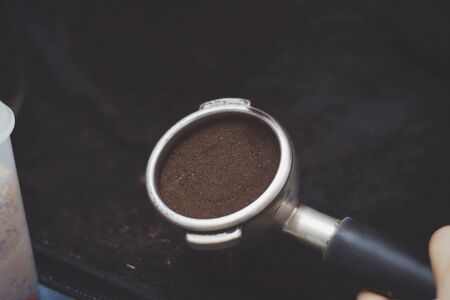Introduction to South Indian Filter Coffee
If you have ever wandered the bustling streets of Chennai at dawn, you would know that there is a certain magic in the air—a heady aroma swirling from every home and street-side kiosk. This is Madras kaapi, or South Indian filter coffee, a drink so deeply woven into the cultural fabric that it is more than just a beverage; it’s an emotion, a ritual, and a symbol of hospitality. In every South Indian household, whether in Bengaluru’s leafy lanes or Kochi’s sea-breeze-kissed verandahs, the day truly begins only after that first hot tumbler of filter coffee. It’s not just about caffeine—it’s about sitting together, sharing stories, and letting life slow down for a moment. As we embark on this journey to recreate the perfect cup of South Indian filter coffee at home, even with minimal equipment, let’s take a brief pause to appreciate why this beloved morning ritual is so unique—and why every sip feels like coming home.
2. Choosing Your Coffee: Selecting the Right Beans and Chicory
If you’ve ever wandered through the narrow bylanes of an Indian city in the early morning, you’ll catch a whiff of something rich, earthy, and unmistakably inviting—that’s the aroma of freshly brewed South Indian filter coffee. To recreate this experience at home, especially when working with minimal equipment, your first step is choosing the right coffee powder or beans. Let’s break down how to make the best pick, whether you’re shopping at your friendly neighbourhood kirana or grinding your own beans.
Tips for Picking Up Filter Coffee Powder from Your Local Kirana
- Ask for “Filter Coffee Powder”: At most kiranas (local grocery stores), simply ask for “filter coffee powder”—the shopkeeper will know what you mean. This blend is usually coarsely ground, perfect for use in the traditional filter.
- Check the Blend Ratio: South Indian filter coffee isn’t just about pure coffee; it’s about the balance between coffee and chicory. Most commercial blends contain 70–80% coffee and 20–30% chicory. If you like your coffee strong and robust, ask for a higher coffee ratio; if you prefer it smooth and creamy, opt for more chicory.
- Freshness Matters: Always check when the powder was ground. Fresher powder means more aromatic brews!
Grinding Your Own Beans: For the Passionate Home Brewer
- Select South Indian Varieties: Look for Arabica or Robusta beans sourced from Karnataka (Chikmagalur), Tamil Nadu (Nilgiris), or Kerala (Wayanad). These have flavour profiles that truly shine in filter coffee.
- Grind Coarse: Use a regular mixer-grinder or a hand grinder at home—just ensure the grind is coarse, resembling semolina (rava).
- Add Chicory: Mix roasted chicory root powder with your ground coffee. The classic ratio is 80:20 (coffee:chicory), but you can adjust to taste.
Coffee vs. Chicory: Finding Your Preferred Ratio
| Coffee % | Chicory % | Flavour Profile | Suitable For |
|---|---|---|---|
| 100% | 0% | Strong, bitter, pure coffee taste; less body | Coffee purists |
| 85% | 15% | Smooth yet robust; balanced aroma and flavour | Everyday drinkers |
| 70% | 30% | Mellow, creamy texture; subtle sweetness from chicory | Lovers of classic South Indian style |
| 60% | 40% | Very mild, rich mouthfeel; pronounced chicory notes | For those who enjoy a gentle cup |
The Role of Chicory in South Indian Filter Coffee Culture
Chicory isn’t just a filler—it’s an essential part of South Indian filter coffee’s soul. Introduced during colonial times to stretch scarce supplies, it now imparts that signature caramelised sweetness and thick body that makes every sip linger on your tongue. Whether you’re picking up powder at your local kirana or experimenting with ratios at home, remember: the real magic lies in finding your own perfect blend—a ritual as personal as your first cup each morning.
![]()
3. Setting Up: Minimal Equipment Required
If you find yourself yearning for a cup of authentic South Indian filter coffee but don’t have the traditional brass or steel filter at hand, fret not, yaar! Making this beloved brew at home is still within reach with a dash of jugaad and some kitchen creativity. The classic South Indian coffee filter consists of two cylindrical containers—one for holding coffee grounds and another to collect the decoction as it drips through tiny perforations. But when in India, we know how to improvise! If you lack the filter, try using a fine mesh tea strainer or even a small steel tumbler with holes poked in the bottom (a true desi hack!). Just place your freshly ground coffee in your makeshift ‘filter’, pour hot water slowly over the grounds, and let gravity do its magic. You’ll need patience, but watching the thick, aromatic decoction drip down is almost meditative. For those who love their coffee strong and kadak, ensure your coffee-to-water ratio leans towards generosity with the grounds. Whether you use a traditional filter handed down from your grandmother or pull off some kitchen jugaad with everyday items, what matters most is that rich, robust flavour at the end—just like a cup from your favourite darshini in Bengaluru.
4. Brewing the Perfect Decoction
If you have ever woken up to the comforting aroma of fresh filter kaapi wafting through an Udupi hotel, you know that brewing the perfect decoction is an art form, deeply rooted in South Indian mornings. No fancy machines required—just your humble coffee filter and a bit of patience.
Step-by-Step Guide to Strong, Aromatic Decoction
- Measure & Layer: Add 2-3 tablespoons of freshly ground coffee powder (preferably a 80:20 blend of coffee and chicory) into the upper compartment of your South Indian filter. Gently tap to level the surface.
- Press & Pour: Place the umbrella-shaped plunger over the powder, then pour hot water (not boiling, just off the boil) evenly—about 100 ml for every tablespoon of coffee powder.
- Patience is Key: Close with the lid and let it brew undisturbed for 10-15 minutes. The slow drip allows for maximum extraction, giving you a thick, strong decoction.
Quick Reference Table: Decoction Ratio
| Coffee Powder | Hot Water | Brewing Time |
|---|---|---|
| 2 tbsp | 200 ml | 10 min |
| 3 tbsp | 300 ml | 15 min |
Brew Tips from the Kaapi Masters
- Avoid pressing down hard on the plunger—let gravity do its job.
- If using readymade filter coffee powder from local brands like Narasu’s or Leo, ensure it’s fresh for best results.
- The stronger and thicker your decoction, the more authentic your filter coffee will taste.
This careful method captures not only caffeine but nostalgia—a true tribute to South Indian mornings where every drop is savoured, whether in a bustling Bengaluru darshini or at home amidst gentle sunlight and birdsong.
5. Mixing It Right: Blending with Hot Milk & Sugar
If you have ever sat in a bustling South Indian darshini, you know the real magic happens at the counter where piping hot decoction meets steaming milk. This step is not just about pouring one into the other—its an art form handed down through generations. To achieve that signature frothy top, start by heating full-fat milk until it is just about to boil, then pour it back and forth between two vessels from a slight height. This creates that creamy, cloud-like layer beloved across Karnataka and Tamil Nadu.
Once your filter coffee decoction is ready and your milk is frothed, it’s time to blend. The classic way? Use a dabarah and tumbler set, or simply any two cups at home. Pour the decoction into your cup first (about 1/4th of the glass for strong coffee lovers), then add frothed milk while holding the cup at a tilt. For best results, transfer the mixture briskly between two cups several times—this aerates the blend and gives you that iconic velvety foam.
And now for the sugar—a matter of personal taste and family pride! Some prefer their kaapi ‘just sweet enough,’ while others go all-in, Anna-style, with generous spoonfuls. If you are new to South Indian coffee, start with one teaspoon per cup and adjust to taste. Always stir well so every sip has balanced sweetness mingling with the robust coffee notes.
Remember: The right mix and froth can turn even simple homemade filter coffee into a heartwarming experience reminiscent of mornings in Chennai or lazy afternoons in Bangalore’s old-school cafes.
6. Serving with Soul: The Traditional Filter Kaapi Experience
If you’ve reached this step, congratulations—you’re about to embrace the heart and soul of South Indian mornings. Making filter kaapi is only half the journey; serving it is where ritual meets delight. In every home from Chennai to Coorg, coffee isn’t just poured—it’s celebrated. The traditional way is to use a stainless steel tumbler and davara.
The Art of Pouring: Tumbler & Davara Dance
Place your hot, aromatic coffee in the tumbler and set the davara (a shallow bowl) beside it. To achieve that signature froth—the very essence of filter kaapi—pour the coffee from a height between the tumbler and davara, back and forth. This aerates the coffee, cooling it slightly while weaving in air for a creamy, rich layer on top. Don’t rush: let the coffee cascade smoothly, creating bubbles that glisten in the morning light. This act is called “meter coffee” pouring in local lingo, a nod to street-side vendors who pour with theatrical flair.
More Than Just Coffee: A Daily Ritual
Sipping filter kaapi isn’t just about taste; it’s an experience steeped in tradition. Families gather over tumblers of strong, sweet brew—discussing politics, sharing laughter, or simply soaking up quiet moments before the day begins. In South India, offering someone a cup of filter coffee is more than hospitality; it’s an invitation to connect.
Savouring Every Sip
Hold your tumbler carefully—some locals pour their kaapi into the davara to cool before sipping, others drink straight from the tumbler for that warming embrace. However you choose, pause for a moment. Notice the aromas of chicory-laced beans mingling with hot milk. Listen to the gentle clink of metal vessels—a soundtrack as old as time in Tamil Nadu kitchens.
So next time you brew South Indian filter coffee at home with minimal equipment, remember: perfection lies not just in technique but in the soulful way you serve and share it. Because every cup is a little piece of southern sunshine—and every pour is poetry in motion.


